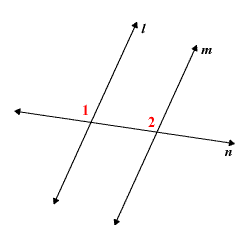geometry theorems/postulates
1/45
Earn XP
Description and Tags
proof stuff basically
Name | Mastery | Learn | Test | Matching | Spaced |
|---|
No study sessions yet.
46 Terms
conjecture
a hypothesis is based upon observations from the postulates. Not yet set in stone.
theorem
A theorem is a proposition that has been or is to be proved by the use of logic on the basis of explicit assumptions (use converse when proving opposite)
postulate
basic assumptions of geometry
segment additon postulate (SAP)
if point B is on AC and is between points A and C then AB + BC = AC
angle addition postulate (AAP)
if point D lies in the interior of <ABC then m<ABD + m<DBC = m<ABC
linear pair postulate (LPP)
if two angles form a linear pair then the angles are supplementary
corresponding angles postulate (CAP)
if two parallel lines are cut by a transversal then corresponding angles are congruent
SSS Postulate
If 3 sides of one triangle are congruent and corresponding to 3 sides of another triangle then the 2 triangles are congruent
SAS Postulate
If 2 sides and an included angle in 1 triangle are congruent and corresponding to another triangle then the triangles are congruent
ASA Postulate
If 2 angles are congruent and the included side
reflexive property
when something is congruent/equals itself
substitution property
when you substitute something in the equation
transitive property
when something both equals to one thing so they equal each other
combining like terms (CLT)
when you simplify the equation by combining things
symmetric property
if x = y , then y = x
commutative property
a+b = b+a
associative property
(a+b) + c = a + (b+c)
Distributive Property
a(b+c) = ab + ac
Definition of Congruent Segments (DOCS)

definition of congruent angles (DOCA)
changes from congruent to equal or vice versa
definition of perpendicular lines
lines/segments that intersect to form right angles
definition of a midpoint
point on a line segment that divides it into 2 congruent parts
definition of an angle bisector
a ray that divides an angle into 2 congruent angles
definition of supplementary angles (DOSA)
a pair of angles whose measures add up to 180
vertical angle theorem (VAT)
if two lines intersect and form a pair of vertical angles then the vertical angles are congruent
midpoint theorem
if M is the midpoint of AB then AM = ½ AB
overlapping segments theorem
If AD has points A, B, C, and D in that order with AB congruent to CD , then the overlapping segments AC and BD are congruent.
Overlapping angles theorem
If two parts of an angle are congruent and there is an overlap then both overlaps are congruent.
Alternate Interior Angles Theorem (AIAT)
If two parallel lines are cut by a transversal then alternate interior angles are congruent
Alternate Exterior Angles Theorem (AEAT)
If two parallel lines are cut by a transversal then alternate exterior angles are congruent
Same Side Interior Angles Theorem (SSIAT)
If two parallel lines are cut by a transversal then same side interior angles are supplementary
Same Side Exterior Angles Theorem (SSEAT)
If two parallel lines are cut by a transversal then same side exterior angles are supplementary
Triangle Sum Theorem (TST)
all angles in a triangle add up to 180 degrees
Isosceles Triangle Theorem (ITT)
If two side of a triangle are congruent then its base angles are congruent
Triangle Inequality Theorem
the sum of the lengths of any two side of a triangle is greater than the length of the 3rd side
Side Angle Inequality Theorem
if one side of a triangle is longer than other side the angle opposite the longer side is larger than the angle opposite the shorter side
Triangle Exterior Angle Theorem
the measure of an exterior angle of a triangle is equal to the sum of the measures of its remote interior angles
Perpendicular Bisector Theorem (there is a converse)
if a point is on the perpendicular bisector of a segment then it is equidistant from the endpoints
Shortest Distance Theorem
the shortest distance from a point to a line is measured along the altitude from the point to the line.
SAA Theorem
If two angle sand a non-included side of one triangle are congruent to the corresponding two angles and non-included side of another triangle then the triangles are congruent
Hypotenuse Leg Theorem (HL Theorem)
If the hypotenuse and a leg of one right triangle are corresponding and congruent to another hypotenuse and a leg of another right triangle, then the two triangles are congruent.
Vertex Angle Bisector Theorem (has a converse)
in an isosceles triangle, the bisector of the vertex angle is also the median and the altitude
Equilateral/Equiangular Triangle Theorem:
every equilateral triangle is equiangular and conversely every equiangular triangle is equilateral
Angle Bisector Theorem
If a point is on the bisector of an angle then it is equidistant from the sides of the angle
Triangle Proportionality Theorem:
If a line parallel to the one side of a triangle it divides the other two sides proportionally
CPCTC:
Corresponding Parts of Congruent Triangles Are Congruent